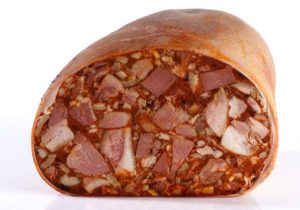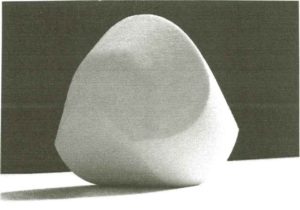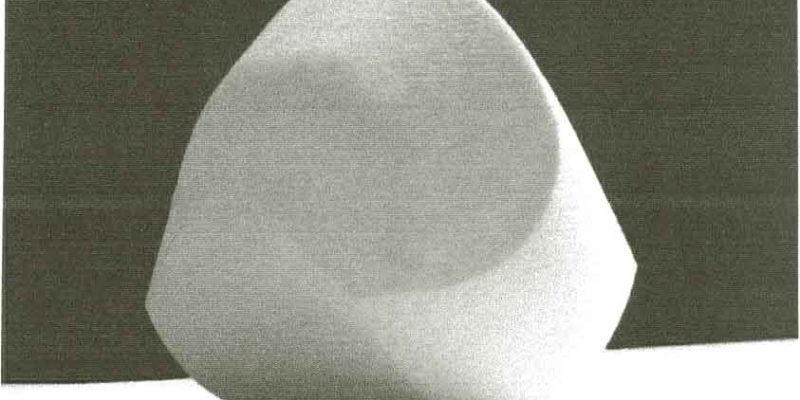Traditionally, ‘gömböc’ has been the name of a kind of Hungarian food specialty, also called ‘disznósajt’ (‘pork-cheese’), similar to the Scottish haggis: pig’s stomach filled with leftovers. In a folk tale, the gömböc devours the members of an entire family one after the other, until the youngest son slits it open from the inside with his penknife.

The ‘Gömböc’ with a capital G, is a far more sophisticated, mathematical object: it is the first known homogeneous object with exactly one stable and exactly one unstable equilibrium point. So basically it is a self-righting object, like a roly-poly, but it is homogeneous. Its existence was conjectured by the Russian mathematician Vladimir Arnold in 1995 and proven by the Hungarian scientists Gábor Domokos and Péter Várkonyi in 2006. Not so surprisingly, evolution seems to have created similar forms for tortoises whose highly domed shell helps the animals in self-righting, which is a matter of survival for them.
This culinary, ethnological and mathematical introduction is meant to underline the significance of the matter C-237/19, recently referred to the European Court of Justice for a preliminary ruling by the Supreme Court of Hungary (in Hungarian: Kúria) and concerning the following 3D mark[1]:

Gömböc Kft. applied for a Hungarian national trademark for the shape of the Gömböc for class 14 “decorative objects”, class 21 “decorative objects made of glass and ceramics” and class 28 “toys”.
The Hungarian Intellectual Property Office (HIPO) rejected the application on the basis that the shape gave substantial value to the decorative items in classes 14 and 21 and that it was necessary to achieve a technical function for toys, for which the self-righting function was relevant.
The applicant appealed to the Metropolitan Court (Fővárosi Törvényszék) and requested the annulment of HIPO’s decision, and, secondarily, a referral to the CJEU. The Metropolitan Court held that a referral to the CJEU was not necessary as sufficient case law was available. It upheld the rejection on both grounds but amended the reasoning and established that the substantial value of the shape lies in its scientific significance and not its special design or aesthetic value. The Gömböc is “mathematics you can touch”.
On appeal, the Metropolitan Court of Appeal (Fővárosi Ítélőtábla) set aside the ground for refusal concerning the technical function but upheld the refusal for all goods on the basis of the substantial value. The Court of Appeal agreed with the HIPO that the shape has aesthetic value and did not agree that substantial value can be based on scientific significance. It confirmed that sufficient CJEU case law was available.
On further appeal, the Supreme Court decided to refer questions to the CJEU for a preliminary ruling, asking, essentially:
(1) In case of a 3D sign, as far as the shape may be necessary to obtain a technical result, can it be taken into account that the relevant public is aware that the shape is necessary in order to obtain the technical result?
(2) Similarly, in case of a 3D sign, as far as the shape may give substantial value to the goods, can the perception or knowledge of the buyer about the actual goods be taken into account?
(3) Lastly, in case of a 3D sign, as far as the shape may give substantial value to the goods, is this ground for refusal applicable to a shape (i) protected by a registered design right due to its individual character, or a shape (ii) whose aesthetic appearance alone gives the goods any kind of value?
Regarding the technical function, the issue is practically whether it shall be taken into consideration that some consumers are aware that the Gömböc is a self-righting object, which many consumers do not know. In the similar Rubik case, the specification of goods (“three-dimensional puzzles”) to some extent defined the function. This application, on the other hand, is simply for “toys”.
Regarding the substantial value, the actual issues are whether the scientific significance of a shape known to some consumers can give substantial value. Moreover, whether the shape of goods protected by design or the shape of “decorative objects” at all can be protected by trademark.
It remains to be seen, who this Gömböc will eat in the end.
[1] The Author is representing the applicant in this case.
_____________________________
To make sure you do not miss out on regular updates from the Kluwer Trademark Blog, please subscribe here.



